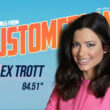Consumers are pretty much unable, and often unwilling, to articulate the kind of meaningful consumer values that allow you to get a good look down the road.
There’s a great Calvin and Hobbs cartoon I love. It shows Calvin and Hobbs walking through the woods, and Calvin says to Hobbs, “Live for the moment’ is my motto. You never know how long you’ve got! You could step into the road tomorrow and – WHAM – you get hit by a cement truck! Then you’d be sorry you put off your pleasures! That’s why I say, ‘live for the moment.’ What’s your motto?”
And Hobbs says, “Look down the road.”
“Look down the road.” That’s my motto too. Well, my professional motto. My personal motto is “Never try and teach a pig to sing. It wastes your time and annoys the pig!” but that’s for another column. No, look down the road. Be able to see things coming at you and your brand. Predict the future for your category.
I’m not talking about “tech” stuff. That would be great to know too, but I’m talking about consumer values and brand expectations. You don’t need to build a time machine and look 10 years down the road. A year to a year-and-a-half will put you light-years ahead of the competition.
No, I’m talking about real predictive metrics that identify consumer values and expectations that describe how consumers will view, compare, and buy in categories. Predictive values describe what consumers truly desire and serve as a measure of what they see your brand delivering. Those desires are not static. So, what you need isn’t a high-def photo, you need a digital motion picture supercharged with psychological acuity.
Those values that help you look down the road change more and more-often. They move faster than traditional research keeps up with them. They change faster than brands keep up too. If you see a blip on your annual brand tracker, it’s too late. If you hear it in a focus group, it’s too late. A new tweet? You got it. it’s too late! You need something in place that lets you look down your sector’s “road” before the elusive becomes the obvious. Oh, and they’re “elusive” because today most brand buying and loyalty decisions and expectations are more emotional than rational and grow at about 25% a year!
Based on our 2020 Customer Loyalty Engagement Index where we examined 95 industry sectors including 1,033 B2C, B2B, and D2C brands, we peg this year’s overall emotional-to-rational values ratio in the consumers’ decision processes at 85:15. BUT DON’T PANIC! Your category could be 80:20 or even 75:25.
Nah, go ahead and panic! Even the best of brands only manage to keep up with the emotional values by about 9%, which leaves a gaping fissure between consumers desire and brand delivery large enough to, well, drive a cement truck through. One thing’s absolutely sure, your category’s ratio isn’t 50:50. Not anymore. And if it is, if rational values in your category actually outweigh emotional values, well, there’s good news and bad news.
The good news is your easiest and likely most-effective brand tactic is a low-lower-lowest price positioning, which requires no stratagem whatsoever! Yay! The bad news is you’ve turned into a commodity. Booo! And unless you’re in the business of selling sand or soybeans, you really don’t want to be a commodity. Admittedly, it’s not easy to identify real emotional brand values and expectations or everyone would be doing it. But that doesn’t stop researchers from trying.
First, they just ask consumers. The thing is, consumers are pretty much unable, and often unwilling, to articulate the kind of meaningful consumer values that allow you to get a good look down the road. Then, researchers try and count stuff, like tweets and shares, but I think I debunked those in a previous column. They’ll ask if you’re “satisfied” or ask how likely you are to recommend something. But satisfaction and recommendation are lagging-indicators. It’s what happened the last time. It’s like trying to look down the road using a rear-view mirror. That tells you where you’ve been but not where you should be going. Online questionnaires are rarely nuanced enough to accurately identify brand values or expectations. Yes, you could do conjoint or factor analyses, but those don’t work very well with truly emotional values. BTW, Imagery isn’t emotion and entertainment isn’t emotional engagement, no matter how much researchers might wish it so. So, what’s a brand to do?
What we do is get under the consumer’s conscious “radar.” We figured out how to measure what they think, opposed to what they say they think. We use a combination of validated psychological research and some really neat higher-order statistical analyses, which fuses emotional and rational aspects of the category. And that allows us to measure real emotions and expectations. Those assessments become the signposts that identify what’s down the road for consumers. If you want a future for your brand, your metrics ought to, well, look down the road, which is why that’s my motto: Look down the road.
For the research wonks among you (if you don’t consider yourself a wonk, feel free to skip to the last paragraph), our algorithm has been independently-validated by The ARF, ANA, 4A’s, and ESOMAR. And a gabillion in-market studies! The output identifies four category-specific, path-to-purchase behavioral loyalty drivers for a category-specific Ideal. It also identifies values that form the components of each driver, along with their percent-contribution to loyalty, engagement, and profitability. Oh, and unlike traditional Q&A research, it’s a measure unconstrained-by-reality, so it ascertains true emotional expectations consumers hold for each loyalty driver. Call it a predictive measure of desire.
It has a test/re-test reliability of 0.93 and produces results generalizable at the 95% confidence level. It’s been successfully used in B2B, B2C, D2C categories in 35 countries. More importantly, it correlates with actual in-market consumer behavior in the 0.80 to 0.901 range. So the analysis looks down the road.
Anyway, your personal motto is, of course, entirely up to you. But if you manage, market, or merchandise a brand, your professional motto ought to be, “look down the road.” Because if you don’t, your competition is going to start looking an awful lot like a cement truck!
 Robert Passikoff is founder and CEO of Brand Keys. He has received several awards for market research innovation including the prestigious Gold Ogilvy Award and is the author of 3 marketing and branding books including the best-seller, Predicting Market Success. Robert is also a frequent contributor to TheCustomer.
Robert Passikoff is founder and CEO of Brand Keys. He has received several awards for market research innovation including the prestigious Gold Ogilvy Award and is the author of 3 marketing and branding books including the best-seller, Predicting Market Success. Robert is also a frequent contributor to TheCustomer.
Photo by mostafa meraji on Unsplash.












